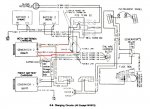The truck has been starting and running great since the problem in this thread was resolved: http://www.steelsoldiers.com/cucv/72149-sudden-no-start-tm-says-replace-starter.html
Today I slightly re routed the starter solenoid wire to gain more clearance to the exhaust. I then jumped it to the 24V starter feed to make sure the starter was still working, it was.
Later, while cleaning the rear most battery terminal post the battery connector found it's was to the firewall and produced sparks- Outstanding . All remaining battery terminals (3) were connected to the batteries when this took place.
. All remaining battery terminals (3) were connected to the batteries when this took place.
I tried to start the truck and everything looked normal while waiting for the glow plugs to cycle. When the ignition was turned to the start position everything slowly went dead. No more dash lights, no start, completely dead. Batteries are charged and combine to about 25V.
I have been through the TMs but need more help. There are a few questions below. I am guessing a fuse and/or fuseable link.
- Am I guessing correctly that it is a fuse/fuse link?
- Based on the way that I shorted the system, which link(s) or fuses could have failed?
- How do you test a fuseable link?
- Does it completely lose continuity like a fuse when blown?
Today I slightly re routed the starter solenoid wire to gain more clearance to the exhaust. I then jumped it to the 24V starter feed to make sure the starter was still working, it was.
Later, while cleaning the rear most battery terminal post the battery connector found it's was to the firewall and produced sparks- Outstanding
I tried to start the truck and everything looked normal while waiting for the glow plugs to cycle. When the ignition was turned to the start position everything slowly went dead. No more dash lights, no start, completely dead. Batteries are charged and combine to about 25V.
I have been through the TMs but need more help. There are a few questions below. I am guessing a fuse and/or fuseable link.
- Am I guessing correctly that it is a fuse/fuse link?
- Based on the way that I shorted the system, which link(s) or fuses could have failed?
- How do you test a fuseable link?
- Does it completely lose continuity like a fuse when blown?





